What is Chetana-shakti?
Chetana-shakti (Sentient energy) is also known as Prana-shakti (Energy that provides vitality), Jivan-shakti or Chaitanya-shakti (Energy of Divine consciousness). The chetana-shakti from the universe is present in the human body since birth. This energy controls the life of the individual. It is the cause of all actions and activities of the human being (for example, breathing, digestion of food, thinking etc.). This energy itself is known as ‘chetana’ or ‘prana’. In Chinese, prana is known as ‘chi’. When the chetana-shakti in the body reduces, the individual feels exhausted and gets distressed in various ways. There are some centres in the human body from where this energy can be obtained; these are known as ‘energy centres’.
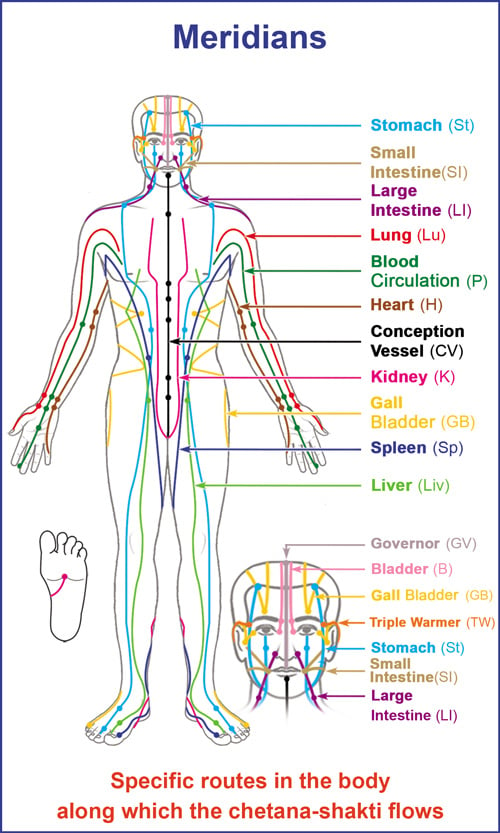
What is Positive (Yang) energy and Negative (Yin) energy ?
The chetana-shakti that human beings acquire from the sun is known as positive (Yang) energy. This body energy flow is from the finger tips to the face, and from the face to the feet of the individual.
The chetana-shakti that human beings acquire from the earth is known as negative (Yin) energy. This body energy flow is from the soles to the trunk, and from the upper trunk through the inner side of the hand to the palms.
Meridians (Jing) – Specific routes
in the body along which the chetana-shakti flows
Chetana-shakti flows throughout the body along specific routes. These paths are known as meridians. In Chinese language they are known as Jing. In all, there are fourteen major meridians, of which twelve are symmetrical on the right and left sides of the body. Hence, both the streams of chetana-shakti flow (Body energy flow) in a similar manner throughout the body. Of the remaining two meridians, one runs along the middle of the back of the body and the other along the middle on the front side of the body. These meridians are associated with major organs in the body and the functions of these organs. The meridians associated with the major organs are known by the names of that organ. One end of each meridian is at a point in the hand, foot or face, and the other end is situated in a major organ.
A. Positive (Yang) and negative (Yin) meridians
Chetana-shakti is classified as ‘positive’ or ‘negative’ depending on its source and the direction of its flow. The Chinese synonyms are ‘Yang’ and ‘Yin’ respectively.
B. The governing meridians
Of the fourteen major meridians, the positive type of chetana-shakti flows in six meridians and the negative type of chetana-shakti flows in six meridians, and the remaining two meridians control the other meridians. These two controller meridians are known as the governing vessel and the conception vessel. Localised effect can be obtained by applying pressure at various points on these meridians. (According to the science of Yoga, the flow of chetana-shakti is associated with the Sūryanaḍi [Sun channel], Chandranaḍi [Moon channel] and Sushumnanaḍi [Central channel].)
The main meridians branch out and they spread throughout the body. (The body has seventy-two thousand naḍis.) Hence, functionally effective area of chetana-shakti flowing in the body is very wide.
C. The direction and order of the meridians
The body energy flow of chetana-shakti through the meridians has a specific route, and is continuous. The flow has its own loop. The continuous and active flow of chetana-shakti does not have a beginning or an end. The direction of flow of chetana-shakti through the meridians and their order in the body is as follows.
-
From the upper portion of the body along the inner side of the hand to the tips of the fingers (Negative)
-
From the tips of the fingers along the back of the hand to the face (Positive)
-
From the face along the outer side of the legs to the tips of the toes (Positive)
-
From the tips of the toes along the inner side of the legs to the upper portion of the body (Negative)
-
The flow of chetana-shakti completes three loops by going through the above mentioned four stages, which also include twelve meridians.
D. The fourteen main meridians
Positive meridians (Yang)
-
Large intestine meridian (LI)
-
Stomach meridian (St)
-
Small intestine meridian (SI)
-
Bladder meridian (B)
-
Triple warmer meridian (TW)
-
Gall bladder meridian (GB)
Negative meridians (Yin)
-
Lung meridian (Lu)
-
Spleen meridian (Sp)
-
Kidney meridian (K)
-
Heart meridian (H)
-
Pericardium or Heart constrictor meridian (P)
-
Liver meridian (Liv)
Governing meridians
-
Governing vessel meridian (GV)
-
Conception vessel meridian (CV)
2. The timetable for the flow of
chetana-shakti through various organs in the body
Chetana-shakti does not flow through all organs in the body throughout the day. The time for flow of chetana-shakti through a specific organ is pre-determined. Every organ receives its supply of chetana-shakti only at a pre-determined time. In the twelve hours that follow, the momentum of chetana-shakti to the organs progressively reduces. Ancient Sages and Ascetics were well-versed in this knowledge. With time, when researchers studied this subject, they realised the truth in it.
A. Time during which sentient body energy flow (chetana-shakti) is optimum through specific organs, specific actions and the meridians.
| Organs / actions / meridians |
Time during which the flow of chetana-shakti is optimum |
|---|---|
| 1. Lungs | 3 – 5 a.m. |
| 2. Large intestine | 5 – 7 a.m. |
| 3. Stomach | 7 – 9 a.m. |
| 4. Spleen | 9 – 11 a.m. |
| 5. Heart | 11 a.m. to 1 p.m. |
| 6. Small intestine | 1 to 3 p.m. |
| 7. Urinary bladder | 3 – 5 p.m. |
| 8. Kidney | 5 – 7 p.m. |
| 9 .Contraction of heart(Note 1) | 7 – 9 p.m. |
| 10.Triple heat (Note 2) | 9 – 11 p.m. |
| 11. Gall bladder | 11 p.m to 1 a.m. |
| 12. Liver | 1 – 3 a.m. |
Note 1 – Contraction of heart is an action
Note 2 – Triple heat is a meridian
If there is an increase in the flow of chetana-shakti of positive meridians, there is a likelihood of worsening of disorder of sleeplessness. When the flow of chetana-shakti increases in the negative meridians, it induces intense sleep and the individual feels drowsy. When there is a balance in the flow of chetana-shakti in positive and negative meridians, even three to four hours of sleep induces enthusiasm and a feeling of happiness.
4. Measures to be adopted when
chetana-shakti reduces or the individual feels exhausted
-
Apply pressure intermittently for two minutes at the midpoint between the wrist and elbow of the right arm on a point which has a diameter of one inch. The individual gets Chaitanya-shakti by this, which reduces exhaustion and increases enthusiasm.
-
Press the second phalynx of the little finger and the base of the little toe for two or three minutes.
-
Hold a comb horizontally on your palm in a manner that its teeth face the fingers, and close the fist so that the teeth create pressure on the fingers when the fist is closed.
-
Hold a comb horizontally on your palm in a manner that its teeth face the wrist, and close the fist so that the teeth create pressure on the palm when the fist is closed.
-
Press the sciatic nerve. This will increase enthusiasm.
Reference : Sanatan Sanstha’s Holy text ‘Acupressure therapy for common ailments‘

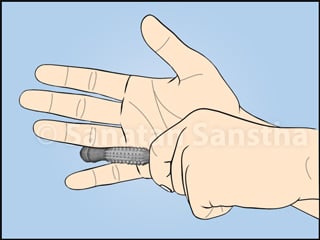
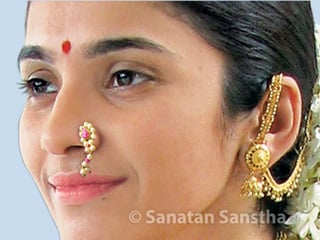 How does Acupressure work unknowingly through ornaments, objects or every action prescribed by Hindu Dharma
How does Acupressure work unknowingly through ornaments, objects or every action prescribed by Hindu Dharma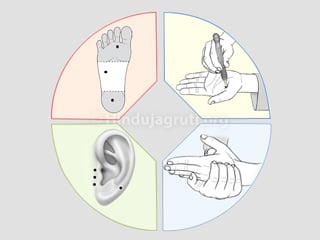 Why special importance is given to Acupressure points on the soles, palms, back of the hand and ears ?
Why special importance is given to Acupressure points on the soles, palms, back of the hand and ears ?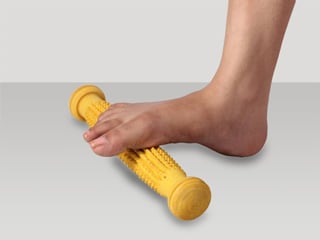 Practical suggestions about Acupressure Therapy
Practical suggestions about Acupressure Therapy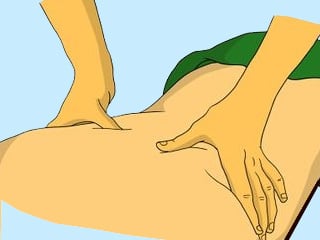 Acupressure Technique used in Acupressure Therapy
Acupressure Technique used in Acupressure Therapy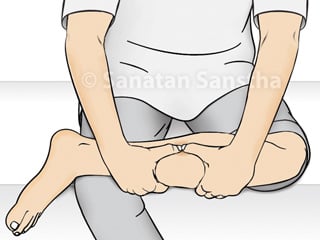 Extent of pressure to be applied on Pressure Points in Acupressure Therapy
Extent of pressure to be applied on Pressure Points in Acupressure Therapy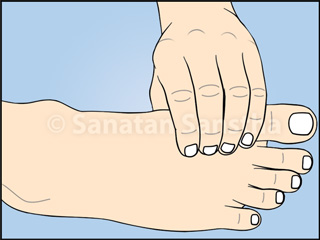 Identifying the exact Acupressure point on body
Identifying the exact Acupressure point on body